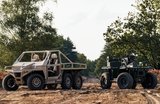South Korea shows off aerospace prowess at Seoul ADEX
KAI has revealed plans for a Next-Generation Basic Trainer that would replace the KT-1, including an electrically powered variant with four engines. (KAI)
South Korea has a vibrant aerospace sector that builds military UAVs, helicopters and aircraft for the domestic market and for export.
Korea Aerospace Industries (KAI) is the most prominent national player, and it was promoting a concept for a new basic trainer aircraft at the Seoul ADEX show held from 19-24 October.
The Next-Generation Basic Trainer (NBT), or Black Kite (Sorigae in Korean), is designed to succeed the KT-1, while an armed variant will replace the KA-1. According to an 80-second promotional video released by KAI, a four-engine variant is powered by battery cells installed in the nose, wings
Already have an account? Log in
Want to keep reading this article?
More from Air Warfare
-
![US Navy acquires additional anti-submarine warfare kits for P-8A Poseidon aircraft]()
US Navy acquires additional anti-submarine warfare kits for P-8A Poseidon aircraft
The contract modification, awarded to Boeing, is worth $61.2 million and will support the US Navy’s (USN's) evolution of its P-8 Poseidon aircraft as continued upgrades are made to boost its capabilities and lethality.
-
![Union slams “self-sabotage” of UK government over Typhoon production]()
Union slams “self-sabotage” of UK government over Typhoon production
The UK Ministry of Defence remains resolute that the Typhoon sits at the heart of the country’s air defence capabilities and is focused on the aircraft’s potential export orders, despite its continued focus on F-35 procurement.
-
![South Korea considers cancellation of second AH-64E Apache helicopter purchase]()
South Korea considers cancellation of second AH-64E Apache helicopter purchase
The likely scrapping of Boeing’s Apache helicopter comes after a huge budget cut approved by the South Korean National Assembly. The helicopter procurement had already been reconsidered by the country’s Joint Chiefs of Staff earlier in the year.
-
![UK to receive 27 additional F-35 aircraft by end of decade]()
UK to receive 27 additional F-35 aircraft by end of decade
The number of aircraft was stated by UK Defence Secretary John Healey during a Defence Committee hearing. It follows on from the UK’s decision to purchase F-35A aircraft to boost its nuclear deterrence, although hurdles and questions about the order still remain.






















